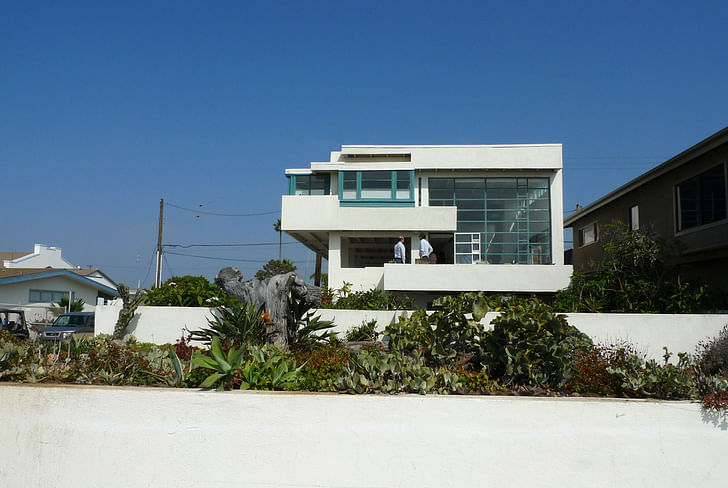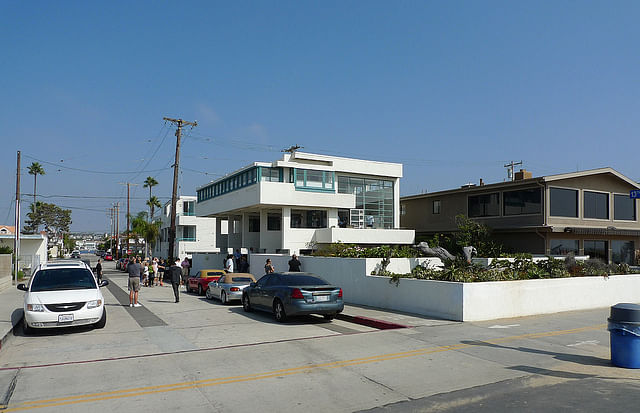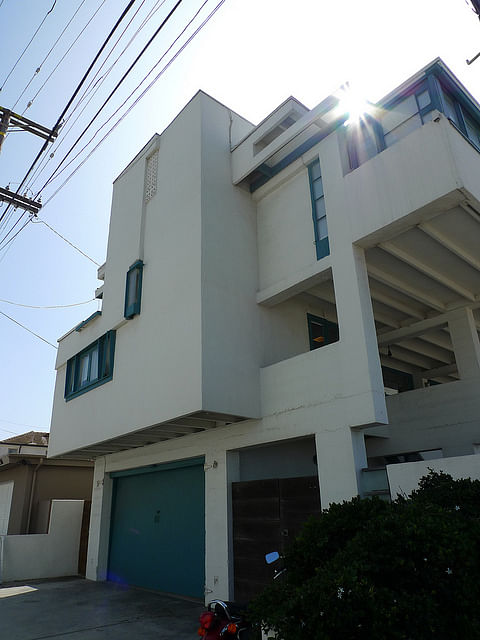

Lovell Beach House, one of the pioneering monuments to modern houses in Southern California, sits there on the corner lot in Newport Beach, still the most radically configured architecture on the block and still holding its own ground as one of the most important examples of what would later become known as California International Style.
I was there yesterday in one of very rare visits, when the house was shown to public and to architecture connoisseurs and to R. M. Schindler lovers.
If there was an architectural treat after long dry period in Southern California lately, this was it.
MAK Center and its brilliant curatorial team under the direction of Kimberli Meyer have aced in a truly rare opportunity to gain access to R. M. Schindler's 1926 Lovell Beach House as a 2011 fund raising event for the MAK Center which has done remarkable work towards, not only preserving the three of R. M. Schindler's houses; Kings Road, Mackey Apartments and Fitzpatrick-Leland House but turning them into venues for art, architecture and urbanism discourse.

The Lovell Beach House was shown by a selected historians, writers and academicians talking for ten minute installments to a group of timed visitors, some emphasizing the importance of the house, some breaking it down to its spatial and structural make up and some, like Paulette Singley, reading passages and making commentary on the early health concepts and dietary writings of the client Philip Lovell.

In her Five California Architects book, writer/historian Esther McCoy's said of Lovell Beach House;
“In the Beach House Schindler developed living space inside five free-standing concrete frames cast in the square figure eights.
The Lovell house was not primarily a drawing board solution- as was much of the work done at that time by the Constructivists in Europe”
In my opinion, if I can explain the pedigree of the house in one word, I would agree with the slight clue of Esther McCoy, the operational insertion of Russian Constructivism holds quite a truth here. Surprised, but not completely.

Since no interior photography allowed to protect the owner's privacy, I can't publish the single shot she let me, her new 'Muslim' friend. That photograph will remain in a sealed file in my computer until otherwise permitted.
However, I can only attempt to narrate Schindler's poetry of space defined by varied spatial volumes and musical play of light, which, can only be roughly translated and could never take the place of the actual lyrical experience.
The concrete skeleton of the house is a telling diagram. The main living room is a rectangular double height space into which bedroom level is cantilevered with a balcony like walkway, creating yet another clear path below with its barely head clearing height. The lowered volume here transverses the entire living room floor from the seaside balcony to back of the house where the kitchen and small dining room is located. This is on the street side to further setback and buffer the private space of the living room. But these are just the mechanical descriptions.
In architectural poetics, the living room bathes you in a beautiful California light, washes your soul and takes your thoughts into the Pacific Ocean through the large window which sets the elevation on that side. Outside is wide and open, nurturing the peaceful inner space, this is something only great architecture can bless you with and masterfully achieved as in Schindler made experience. Upon that moment, one feels why architecture is important.
Orhan Ayyüce, Los Angeles
A long-time contributor to Archinect as a senior editor and writing about architecture, urbanism, people, politics, arts, and culture. The featured articles, interviews, news posts, activism, and provocations are published here and on other websites and media. A licensed architect in ...
14 Comments
Arms out-stretched, body radiant. A sun-drenched cave whose entrance is a veil of light...
Lovell Beach House interior , an early bw photo
http://www.architectureweek.com/2006/0802/images/13150_image_7.150.jpg
eric that photo might as well be called interior corner detail.
Orhan,
Lovell Beach House: Hard to visit, harder to tour, impossible to photograph the interior.
For such an iconic Schindler (The Lovell was the feature cover photo of Gebhard's1972 monograph) there is a poverty of insider photos . Just a few B&W was all I could find.
The 1999 Taschen monograph does has a full page blown-up black and white of 'the corner detail' . But your unpublished photo may be the only contemporary interior view albeit an 'unlisted' one - and it's in color!
Yours is a true insider snapshot.
eric chavkin
If you are wondering how the 'Muslim' bit came about, the owner, who, in an unusual moment made a book reference on her coffee table out of context and unexpectedly. That surprised me and the few listeners around her as she mentioned how Muslims helped the Jews during WW2 in France. After that, I engaged a conversation with her explaining little spoken fact these days that Muslims were historically best friend of the Jews going back to times of Spanish Inquisitions when they were granted safety and freedom in Ottoman Empire and how that friendship continued for centuries with many European and Balkan Jews finding safety in Turkey in WW2. That is how I became her 'new Muslim friend...'
on behalf of those of us unfortunately not living in LA anymore, thanks for posting this orhan.
el jeffe, thanks for your appreciation. I hope you get to watch my conversation with Ray Kappe this Saturday.
beautiful.
Thanks for the tour and the observations, Orhan. It's not often we get a look at this treasure -- even in "contemporary drag" (?). Gone are the unpainted wood surfaces. Even the muntin-and-panel pattern seen in the "interior corner detail" has disappeared . . .
As a contrast to (or context for) Orhan's new photos, here are some older documents.
Thanks for the archive drawings and the photos SDR.
It is interesting to compare the HABS drawings you linked -- which amount to an as-built + as-modified record, c 1968 -- with Schindler's own plans, elevations, and section. The isometric views of the semi-freestanding cabinet construction which separates the living and dining spaces -- a typical RMS invention -- are particularly welcome. I assume that furnishing was in place -- perhaps painted turquoise ?
The service stair at the rear of the house is shown variously in photos and drawings; it appears to be a composition of wood horizontals and wood and/or metal verticals. Did you find that stair intact as well ?
sdr, the back stair seems to be in its original place. however the kitchen area and bathroom seems to be gone through yet another minor modification since the surveyor's drawing.
yes, the original divider cabinets are in place in the living room and they are painted.., white.
here is an exterior stair detail;
and one of the fascinating details of the house, thin stucco railings down to 3" throughout;
one more drawing..
This house is perversely intriguing - thanks for posting this Orhan.
Block this user
Are you sure you want to block this user and hide all related comments throughout the site?
Archinect
This is your first comment on Archinect. Your comment will be visible once approved.